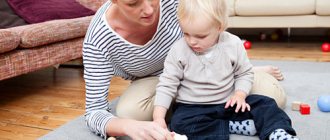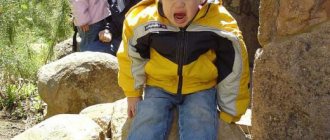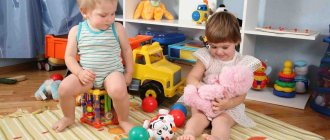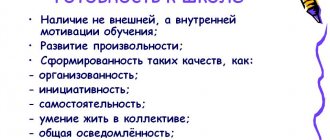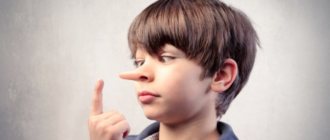What does a baby learn from 0 to 1 month?
The first month of a newborn's life is considered a period of adaptation. During these 30 days, the new member of your family must have time to do a huge amount of work to rebuild his body: for most of his life he existed in an aquatic environment, where he was provided with heat, nutrients and oxygen, and now he needs to breathe on his own, regulate the heat exchange system himself, extract milk from mother's breast.
This requires enormous energy expenditure, so in the first month the baby sleeps and eats most of the time. In the first weeks of life, sleep is very important for a baby: during sleep, he grows, and the body gets used to the new environment. The duration of wakefulness during the day in the first month usually does not exceed 2–4 hours. Breastfeeding quickly improves: a newborn eats on average every 2 hours, at night 3-5 times (don’t forget - everything is very individual). Your baby will set his own sleep, feeding and wakefulness schedule depending on his physiological characteristics and temperament. Your task as parents is only to notice and maintain these rhythms, learning to recognize and satisfy the child’s needs.
Physical and psycho-emotional development during this period occurs by itself, almost imperceptibly, but continuously. Despite the fact that the baby does not yet demonstrate any special achievements, he absorbs a lot.
You can keep a diary where you will record all your baby’s achievements: he smiled for the first time, started crawling, took his first steps. This will help to track the dynamics of development and preserve pleasant memories for life.
Physical development:
- Movements of arms and legs are chaotic;
- Hypertonicity of the arms and legs remains, the fists are tightly clenched;
- Raises his head while lying on his stomach;
- Learns to fix the gaze on a stationary object;
- Innate reflexes are still highly developed, thanks to which the baby adapts to the environment - sucking, searching (searching for the mother's breast), grasping (squeezing everything that falls into his fist), walking reflex (moves his legs, as if walking, if you hold it in an upright position on a hard surface), swimming, Mohr's reflex (brings the arms and legs together and apart, reacting to a loud and sudden sound), etc. As the child develops, they will gradually fade away, leaving room for the basic reflexes of an adult (blinking, sneezing, yawning , flinching, etc.).
Psycho-emotional development:
- Can please you with your first smile (the so-called physiological smile);
- Makes the first sounds (sniffles, groans), and if they talk to the child a lot, pleases the parents with cooing (humming);
- Reacts by flinching, freezing, or crying to sudden and loud sounds;
- Stops crying when picked up;
- Actively helps during feeding (makes himself more comfortable, looks for and catches the nipple of his mother's breast in his mouth).
Now your baby needs especially close physical and visual contact with his mother and her response to his needs, which lays a solid foundation for the child’s psychological well-being. During this difficult time, the family’s strength and cohesion are tested: so that the mother can devote herself to the newborn, let other family members take on all the other concerns about the house.
Definition of the concept in psychology
The early postnatal period of fetal life in age periodization is called “newbornness”. It lasts from the first day of life until the moment when the baby develops a revival complex. As a rule, this occurs at the threshold of 2 months of life.
New birth is recognized by psychologists and physiologists as a crisis period in a child’s development, since he needs to adapt to new living conditions and adapt to the social environment. Having a basic set of innate reflexes, it develops new stable forms of response to external phenomena and events. In psychology, the revitalization complex is a kind of signal that the baby’s primary adaptation to society has been successful.
The first manifestations of the revitalization complex in a child appear at the age of 3 weeks. Its signs are:
- the baby’s ability to focus attention on objects and sounds;
- freeze when an adult appears and respond with a smile to his gentle voice;
- the ability to express joy with an enthusiastic cry.
For the first time, N.M. drew attention to the revitalization complex in a child. Shchelovanov at the beginning of the 20th century. He defined the essence of this phenomenon as the appearance of a set of emotional and motor reactions of the child to the actions of parents or other close relatives addressed to him.
How does a baby develop by 2 months?
At this age, the baby sleeps noticeably less: periods of prolonged daytime wakefulness appear. Daytime sleep is shortened. A nighttime sleep pattern is being developed: now its duration is 10–12 hours with breaks for feeding, during which the baby may not wake up completely.
Physical development:
- Lying on your stomach, hold your head at an angle of 45 degrees for some time;
- Rolls over from side to back;
- Holds the head in an upright position for 1 – 2 minutes;
- Follows moving objects with his eyes;
- Turns his head towards the sound;
- Hypertonicity of the hands disappears;
- Some reflexes of the newborn (grasping, walking reflex) fade away.
Psycho-emotional development:
- Demonstrates a “revival complex” - active movements of the arms and legs in response to the appearance of the mother, humming, a wide smile;
- Freezes, listening to sounds;
- Smiles in response to affectionate treatment, conversation, smile;
- Reacts to familiar voices;
- He hums and sings some sounds.
The development of perception of shape and color can be stimulated by hanging pictures with bright, clear shapes and patterns on the sides of the crib: black and white, red, yellow, blue, green, orange.
What can a baby do by 3 months?
Perhaps the main achievement of this month and joy for parents is the emergence of a routine that the baby builds together with his mother. There is already a distinct time of waking up, feeding and falling asleep with two or three (sometimes four times) daytime sleep.
At this age, the baby already knows how to express his dissatisfaction by screaming and crying and requires attention. Observant parents can notice the first manifestations of a child’s character.
Physical development:
- Holds his head confidently when lying on his stomach and in an upright position;
- When lying on his stomach, he rests on his forearms;
- Examines and sucks hands;
- Rolls from back to side;
- Tries to grab and hold the toy in his hand, and then pulls it into his mouth.
Psycho-emotional development:
- Maintains eye contact;
- Smiles and laughs;
- It can hum for a long time, the humming becomes varied;
- Recognizes the faces of loved ones;
- Fixes gaze on stationary objects for a long time (up to 5 minutes).
Arrange a family council and make a list of character traits of the baby's close relatives. Pay special attention to undesirable qualities. This is a good reason to start thinking about what methods of education could help correct them, and which ones will help develop those qualities that you dream of seeing in your heir.
Baby development by 4 months
At 4 months, the main thing for a child is coordination of eye and hand movements. The grasping reflex gradually weakens, hand movements become conscious and take on meaning, especially when you need to reach something, the grasping reflex gradually fades away. It is your own hands (and sometimes even feet) that become the baby’s most favorite toys.
Active salivation may appear - this is how teeth begin to erupt. Don't be surprised if this happens only after a couple of months or more.
Physical development at 4 months:
- On his own or with the help of an adult holding him by one hand, he turns over from his back to his stomach (and sometimes from his stomach to his back);
- Reaches for objects, feels them;
- He licks his fingers, sucks his fist, and for the same purpose tries to reach the legs to his mouth;
- Rhythmically jerks its legs and transfers weight to them;
- Hypertonicity of the legs disappears.
Psycho-emotional development at 4 months:
- In communication he gives preference to his mother, recognizes her, rejoices when she appears, can be capricious when she leaves for a while;
- “Coos” with his parents when he is in a good mood;
- Actively smiles, laughs, squeals with delight;
- Reacts to the sound of his name;
- Can spend a long time occupied with toys hanging over the crib;
- Babbling appears and the first syllables are “ma”, “ba”, “pa”.
Developmental stages at 5 months
The fifth month passes under the motto “I want to move!” Let the baby continue to try to roll over, rock, and sit down, the main thing is to ensure his safety at these moments. If you notice that your baby needs more space than he has in his crib or playpen, you can lay him out on the floor. Prepare the surface for this in advance: it should be clean and pleasant for contact with the baby’s delicate skin; a soft mat is perfect for these purposes.
During this period, the sleep, wakefulness and feeding patterns may begin to change again. Sometimes the baby may not wake up all night, even for feeding, or get up very early and no longer get enough sleep in the morning.
Physical development at five months:
- Lies on his stomach for a long time, leaning on his outstretched arms, and may begin to crawl on his bellies;
- Confidently rolls over from back to stomach;
- Sits with support, while the back is strongly bent;
- Entertains himself by playing with his own arms and legs;
- Confidently grabs objects and holds them in his hands for a long time.
Psycho-emotional development at five months:
- Recognizes mother's voice;
- Distinguishes the faces of loved ones from strangers;
- Reacts differently to different tone of address - smiles in response to an affectionate tone of voice and frowns when there is a strict intonation;
- It hums long and melodiously;
- He himself encourages parents to communicate - he smiles, babbles, stretches his arms; gets capricious if there is not enough communication.
At this age, children often confuse day with night (this feature can appear earlier, but is more common between 4 and 6 months). Think about why: maybe your baby has too long naps, or he doesn't get enough exercise during the day, or the air in the room is too dry and warm.
Speech, intelligence, worldview
Children with autism have impaired perception of the overall picture of the world. They analyze the object not as a whole, but divide it into details. They are interested in the car not as a form of transport, but only because its wheel moves.
Such children are not characterized by the desire to understand the world, study the properties of an object, its purpose. They choose attractive elements for themselves and follow them. Cognitive questions “why, why” lag in time.
Autistic children have a hard time getting interested in toys, but they focus on sensory stimuli. For example, a baby loves classical music so much that already at one year old he finds the right record in a stack and puts it in the player.
However, what is amazing is the ability of such children to remember what they, looking from the outside, do not pay attention to, hear what they do not listen to, see what they do not look closely at. When it is subsequently possible to establish verbal contact with them, the children talk about many things that, as it seemed, did not interest them.
As for memory, it can be said to be selective. They remember very well what is significant to them: the situation in the apartment, habits in the family, etc. Therefore, any violation of the routine causes indignation in them. Children are also good at remembering events that made them feel afraid.
A special feature of little autistic children is mechanical memory. They perfectly remember poetry, reproduce complex drawings and songs.
The speech of autistic children also has its own characteristics. In infancy, they are not characterized by humming and babbling. They appear very late. The first words are spoken on time, but these are not the usual “mother”, but completely different words that are not used for direct communication.
Many children's speech is either very poor, with a small vocabulary, or practically not developed at all. They hum, smack, and speak their own language. The words are incoherent and may use expressions taken from the cartoons they have watched.
Echolalia is observed - repetition of words addressed to the autistic person. Sometimes very complex expressions are repeated, but purely automatically, without understanding the meaning. There is a reversal of pronouns; when a child with ASD is asked what your name is, he answers: “Your name is Petya.”
The meaning of the speech of an autistic child is understandable only to close people, since he operates with abstract concepts. For example, when mom is angry, she answers her: “Have mercy, madam.”
Even if the baby’s speech is quite well developed, and his vocabulary is very rich, he is still incapable of dialogue. He speaks only about what interests him, in the form of a monologue, while the intonation of his statements suffers.
Autistic people easily learn foreign languages. But, as teachers note, they also master their native language as a foreign one.
In general, speech with RDA is also stereotypical. It is often incomprehensible to others, as it expresses the personal interests of its bearer. Spontaneous speech used in communication is poorly developed; children better perceive indirect speech addressed to others. They can speak clearly and without hesitation, using complex expressions, in the form of a monologue or echolalia, but they stumble, get confused and speak blurredly when trying to start a dialogue.
How does a baby develop at 6 months?
What would you like to eat? Yes, it is at six months that the baby begins to show interest in food. This is a new stage in its development, and not at all evidence of a lack of milk in the mother or malnutrition of the child. From 6 months you can introduce the first complementary foods.
Physical development:
- Sits down from a position on all fours;
- Rolls over from stomach to back and from back to stomach;
- Gets on all fours and rocks back and forth, preparing for full crawling (some children are already quite good at crawling);
- Follows the movement of the toy for a long time;
- The first tooth may emerge.
Psycho-emotional development:
- Deals with one object - moves from hand to hand, pulls into mouth, moves away, examines;
- Repeats syllables and sounds after an adult, imitating his voice intonations;
- Tries to imitate the movements of an adult - pats, knocks, squeezes, shakes a toy;
- The consonants “z”, “s”, “v”, “f” appear.
The baby still puts everything in his mouth into his mouth, and if your baby has already crawled, be on the lookout. Carefully check the apartment to ensure it is safe for your child to move around it. To do this, put yourself in the baby’s position in the literal sense: get on your knees and crawl across the entire apartment (or that part of it in which you will place the baby on the floor), removing any objects (perhaps even changing the arrangement of furniture) that pose a danger to the child. baby. Pay special attention to wires, sockets and heavy objects that your baby could knock over.
Child development at different age stages
Infancy (first year of life)
At birth, the child is physically separated from the mother.
He finds himself in completely different conditions: cold, bright light, an air environment that requires a different type of breathing, the need to change the type of food. Hereditarily fixed mechanisms - unconditioned reflexes - help the child adapt to these new, alien conditions. What unconditioned reflexes does a newborn have? This is, first of all, a system of food reflexes. When you touch the corners of the lips or tongue, sucking movements appear, and all other movements are inhibited. Because the baby is completely focused on sucking, this response has been called "feeding focus."
Among the unconditioned reflexes, protective and indicative ones stand out. Some reflexes are atavistic - they are inherited from animal ancestors, but are useless for the child and soon disappear. For example, the reflex, sometimes called the “monkey” reflex, disappears already in the second month of life.
Unconditioned reflexes of the newborn
| Irritants | Reflexes |
| Effect of bright light | Eyes close |
| Slap on the bridge of the nose | Eyes close |
| Clap your hands near the child's head | Eyes close |
| Turning the baby's head to the right | The chin rises, the right arm extends, the left bends |
| Elbow extension to the sides | Arms bend quickly |
| Pressing a finger on a child's palm | The child's fingers clench and unclench |
| Pressing a finger on a child's sole | Toes curl |
| Using a scratching motion, we run our finger along the sole from the toes to the heel. | The big toe rises, the rest are extended |
| Pin prick of the sole | Knee and foot bend |
| Raising a lying child belly down | The child tries to raise his head, stretches his legs |
By the end of the first month of life, the first conditioned reflexes appear. In particular, the baby begins to respond to the feeding position: as soon as he finds himself in a certain position on the mother's lap. He has sucking movements. But in general, the formation of conditioned reflexes is characteristic of a later time.
How can you describe the mental life of a newborn? The brain of a small child continues to develop, it is not fully formed, therefore mental life is connected mainly with the subcortical centers, as well as with an insufficiently mature cortex. The sensations of a newborn are undifferentiated and inextricably fused with emotions, which made it possible to talk about “sensory emotional states or emotionally emphasized states of sensations” (L. S. Vygotskaya).
Important events in the mental life of a child are the emergence of auditory and visual concentration. Auditory concentration appears at 2-3 weeks. A sharp sound, say, of a door slamming, causes a cessation of movements, the child freezes and becomes silent. Later, at 3-4 weeks, the same reaction occurs to a person’s voice. At this time, the child not only focuses on the sound, but also turns his head towards its source. Visual concentration, which appears at 3-5 weeks, is externally manifested in the same way: the child freezes and holds his gaze (of course, not for long) on a bright object.
The newborn spends time sleeping or dozing. Gradually, individual moments, short periods of wakefulness begin to emerge from this drowsy state. Auditory and visual concentration give wakefulness an active character.
A child comes into this world weak and completely helpless. Such helplessness and complete dependence on an adult constitute the specificity of the social situation of an infant’s development.
A newborn, having acquired the ability to respond to the voice of the mother caring for him, to see her face, establishes new subtle emotional connections with her. At about 1 month, the baby, seeing his mother, fixes his gaze on her face, throws up his arms, quickly moves his legs, makes loud noises and begins to smile. This violent emotional reaction has been called the “animation complex.” The animation complex, which includes a truly human characteristic—the smile—marks the emergence of the first social need—the need for communication. And the development of a child’s need for communication means that he is moving into a new period in his mental development. The transitional stage of newbornhood ends. Infancy proper begins.
Infancy
The baby is growing rapidly. During the first year of life, the growth of a healthy child increases approximately 1.5 times, and the weight increases almost 2 times.
Physical development of the baby
| Appearance time | Motor development |
| 1 month | Raises chin |
| 2 months | Raises the chest |
| 3 months | Reaches for an object, but usually misses |
| 4 months | Sits with support |
| 5-6 months | Grabs objects with hand |
| 7 months | Sits without support |
| 8 months | Sits down without assistance |
| 9 months | Stands with support; crawls on his stomach |
| 10 months | Crawls, leaning on hands and knees; walks holding with both hands |
| 11 months | Stands without support |
| 12 months | Walks holding on with one hand |
Perception
After the second month, concentration becomes quite long; by 3 months, its duration reaches 7-8 minutes. At 4 months, the child not only sees, but already looks: actively reacts to what he sees, moves and squeals.
A child in infancy perceives the shape of objects, identifies their outline and other elements.
We can say that in infancy, children are already able to navigate many parameters of objects. They are attracted by contrasts, the movement of observed objects and their other properties.
By 2-3 months, infants usually show interest in objects that are somewhat different from those they have previously observed.
The child distinguishes visually perceived objects by shape, complexity and color. Active interest in color appears later, from 6 months.
Spatial perception also develops, in particular depth perception. American psychologists conducted a beautiful experiment with a “cliff”: a baby was placed on a glass table, under which there were two large boards attached at different levels. The difference in the levels of these boards, covered with bright, large-checked material, created the illusion of a cliff. A small child, tactilely feeling the smooth surface of the glass, crawls towards its mother, not noticing the depth. After 8 months, most children avoid the “cliff” and begin to cry.
Movement and actions
Movements of the baby's hands directed toward an object and feeling an object appear around the fourth month of life. At 5-6 months, the child can already grasp an object, which requires complex hand-eye coordination. Grasping is the child’s first purposeful action; it is a prerequisite, the basis for mastering manipulations with objects.
In the second half of the year, hand movements and corresponding actions develop intensively. The child waves the objects he has grabbed, knocks, throws and picks them up again, bites, moves from hand to hand, etc. Chains of identical, repeating actions unfold, which Jean Piaget called circular reactions. After 7 months, “correlating” actions occur: the child puts small objects into large ones, opens and closes the lids of boxes. After 10 months, the first functional actions appear, allowing relatively correct use of objects, imitating the actions of adults. The child rolls the car, beats the drum, and brings a cup of juice to his mouth.
By the end of the year, the child begins to explore the world of human objects and master the rules of action with them. Various actions lead him to discover more and more new properties of the objects around him. Orienting himself in the surrounding reality, he is interested not only in “what it is,” but also in “what can be done with it.”
Perception and action are the basis that allows us to judge the initial forms of visual-effective thinking in infancy.
By the end of 1 year, the child is involved in fairly complex game actions.
Memory
The cognitive development of an infant involves the inclusion of memory mechanisms, of course, its simplest types. Recognition comes first. At 3-4 months, he recognizes the toy that an adult showed him, preferring it to others in his field of vision; a 4-month-old child distinguishes a familiar face from an unfamiliar one.
After 8 months, reproduction appears - the restoration of an image in memory when there is no similar object in front of the child.
During infancy, along with cognitive development, emotional development is observed. This line of development also directly depends on communication with close adults. In the first 3-4 months, children exhibit a variety of emotional states: surprise in response to the unexpected (inhibition of movements, decreased heart rate), anxiety in response to physical discomfort (increased movements, increased heart rate, squinting of the eyes, crying), relaxation when a need is satisfied.
After 3-4 months, he smiles at acquaintances, but is somewhat lost at the sight of an unfamiliar adult. At 7-8 months, anxiety when strangers appear increases sharply.
Around the same time, between 7 and 11 months, the so-called “fear of separation” appears - sadness or acute fear when the mother disappears (when she is gone for a long time or she just left for a while).
When communicating with a mother or another close person, by the end of 1 year the baby strives not only for purely emotional contacts, but also for joint actions.
Speech development also begins in infancy
In the first half of the year, speech hearing is formed, and the child himself, with joyful animation, makes sounds, usually called humming. In the second half of the year, babbling appears, in which it is possible to distinguish some repeating sound combinations, most often associated with the actions of the child. Babbling is usually combined with expressive gestures. By the end of 1 year, the child understands 10-20 words spoken by adults, and he himself pronounces one or several of his first words, similar in sound to the words of adult speech. With the appearance of the first words, a new stage in the child’s mental development begins.
Year 1 crisis
The transition period between infancy and early childhood is usually called the 1 year crisis. Like any crisis, it is associated with a surge of independence and the emergence of affective reactions. Affective outbursts in a child usually occur when adults do not understand his desires, his words, his gestures and facial expressions, or understand, but do not do what he wants. The word “impossible” acquires particular relevance during a crisis.
The main acquisition of the transition period is a kind of children's speech, called autonomous. It differs significantly from adult speech both in sound form (phonetic structure) and in meaning (semantic side). The child has his own logic, and his words become ambiguous and situational.
The language of a small child is ungrammatical. Words are not combined into sentences, but pass into each other as interjections, resembling a series of incoherent exclamations.
Children's speech is understandable only to the closest people who are constantly near the child and understand the meaning of his words.
So, a one-year-old child, entering a new period - early childhood - can already do a lot: he walks or at least tries to walk; performs various actions with objects; his actions and perceptions can be organized with the help of speech, since he understands the words of adults addressed to him. He begins to speak and, although his speech is situational and ambiguous, incomprehensible to most others, his opportunities for communication with loved ones expand significantly. The cognitive and emotional development of a child is based primarily on the need to communicate with adults - the central neoplasm of this age period.
What can a 7 month old baby do?
Have you noticed how your child has changed, how much easier it has become to communicate with him? Yes, the baby’s sensory development is gaining momentum: by 7 months, his hearing and vision are developed almost like an adult’s. The nervous structures and connections that are responsible for the quality of sensations are already fully formed. The baby has learned to connect sound and visuals and understands that they can have the same source.
Physical development:
- Crawls well;
- Sits confidently with a straight back;
- Pulls himself up and tries to stand up in the crib;
- When supported by both hands, stands upright and can step with his legs;
- Eats well from a spoon, drinks from a cup held by an adult;
- Improves fine motor skills, loves finger games “Magpie-Crow”, “Ladushki”.
Psycho-emotional development:
- To the question “Where?” finds the object in its usual place with his gaze;
- He babbles for a long time, repeating the same syllables - “ba-ba-ba”, “ma-ma-ma”, “pa-pa-pa”;
- Enjoys looking at pictures in books;
- Plays with toys for a long time;
- Reaches towards his reflection in the mirror.
At this age, the baby may have a need to constantly chew, as his teeth and jaws are actively developing and they need an increased chewing load. You can give your baby pieces of hard apple, carrot, dried fruit, and cookies to chew.
Baby development at 8 months
Where's mom? If at 7 months babies are worried when their mother is not around, then at 8 months children develop a fear of strangers. One follows from the other, and both phenomena are normal for each of these stages of growing up. You will do the right thing if you try to surround your baby with special care, affection and emotional warmth, and be sensitive to his needs. Scientific research has shown that children who receive a lot of warmth and affection in infancy are much more resistant to stress as adults.
Physical development:
- Crawls at high speed and over any distance;
- Rise up and down from a sitting position with support;
- A “tweezer grip” appears - can grasp small objects with the thumb and forefinger;
- He holds and eats pieces of food in his hand;
- Makes the first attempts to move with an extended step, holding onto a support.
Psycho-emotional development:
- Feels confident in a familiar space;
- The range of emotions expands - you can notice dissatisfaction, surprise, joy, delight, perseverance;
- Repeats syllables loudly and clearly;
- The vocabulary increases, the first conscious words appear - “mom”, “dad”, “baba”, “give”;
- Begins to show increased interest in new objects, expressing surprise and wariness with facial expressions.
When your baby is 8 months old, he is already able to control the volume of his voice, and from now on you can sometimes whisper to each other. If you are not yet reading to your baby before bed, now is a great time to start: you will practice the bedtime reading ritual and once again practice regulating the volume of your voice.
Relationship between parents and children
A close emotional connection between parents and child begins to form from the first days of the appearance of a new member in the family. First, it is based on satisfying the physiological needs of a small person. Children quickly learn to use age-appropriate ways to attract an adult's attention.
Emotional contact between parents and infants is the key to normal mental and personal development. Trusting relationships in the family give the child a feeling of safety and security. Subsequently, a child who did not experience a lack of communication in infancy becomes inquisitive, independent, proactive, and purposeful.
How does a baby grow at 9 months?
Time to talk! Some children prefer to postpone this moment a little. But for many, this is a period of active speech development. The baby knows his own name, the names of all his loved ones, the names of the most familiar objects and concepts. Talk to him as much as possible, try to enrich the sound range with meaningful statements in the form of requests, wishes, and coherent stories.
During this period, it is important to continue to learn how to say “no” to your child. Pay attention to how exactly you pronounce the prohibiting word. It’s best to calmly and firmly say: “Don’t touch the socket, it’s dangerous,” and not jokingly wag your finger and coo: “My sweetie, please leave the socket alone.” Otherwise, the baby will not take your words seriously and, on the contrary, will try to repeat the forbidden action.
Physical development:
- Quickly crawls in different directions, climbs on all fours onto a pillow, elevation, ladder of a children's slide, tries to open drawers;
- Walks holding onto support;
- Sits down from a lying position and lies down from a sitting position;
- Repeats the movements of an adult - raises and lowers his hands, claps his hands;
- Improves actions with small objects - takes them out and puts them back into the container, opens (removes) the lids.
Psycho-emotional development:
- Rejoices in response to the result of a successful action (opened the box);
- Understands the meaning of the word “no”;
- Finds an object regardless of its location;
- Understands and follows simple instructions - “lie down”, “get up”, “throw”, “on”, “give”;
- Knows the name and purpose of individual objects - cups, spoons, bottles, combs.
Remember: if “no” is said for any reason, the baby will soon get used to this word and stop paying attention to it. In the future, this may lead to the child not being able to respect you and your wishes. Therefore, it is best to use prohibitions only in cases where it is necessary to protect the baby from danger.
Adult tasks
There is still very little that can be taught to a newborn. It is entirely up to adults to launch systems associated with the emotional regulation of behavior. Verbal communication with a newborn, physical contact, eye-to-eye gaze and a smile - without which the attachment mechanisms will not “work” and, accordingly, the child will not acquire one of the most powerful mechanisms for motivating behavior, when a person agrees to something for the sake of the value of the relationship . It has been shown that a mother’s caring behavior towards her newborn has a dramatic effect on the subsequent physical and intellectual development of the child (see the article “Activities or hugs”).
An adult should try to be in physical contact with the child. Even if the mother does not breastfeed the newborn, bottle feeding should be done while holding the baby in her arms, holding him close to her. You should try to give the baby a massage, gently stroking him, avoiding sharp, unpleasant touches. It is important to talk to the child and sing songs to him, starting from the first days of life. It is important to look into his eyes when communicating because babies are more attentive to their mother's face if her gaze is directed directly at them. It is important to smile at a baby because it “launches” the work of the limbic system of the brain - a system that plays a fundamental role in all subsequent emotional and social development of the child.
An adult can help a newborn by creating conditions for the development of those movements that should appear during this period: pulling him by the arms when he lies on his back, using his grasping reflex, laying him on his tummy so that he tries to raise his head, helping him fix your gaze on the toy and follow its movement, when his eyes can move in a friendly manner (the toy should be large enough and bright), shift him in the crib so that he does not turn only one side to the light source. It is very important not to limit the child’s movements unless there are special medical indications for this.
An adult can play music for a newborn. This will contribute to the development of his auditory perception system. In no case should you protect your child from different types of information when he is awake.
Many parents are interested in the question of whether it is necessary to create a strict routine for their newborn (feeding, putting to bed, walking strictly according to the clock). Currently, doctors are inclined to believe that the child should set his own routine for his life. This is partly explained by the fact that by imposing a certain regime on a child, an adult ceases to be sensitive to his needs, which disorients the child and can lead to the formation of his personality according to an anxious type (see the article “Anxious Child”).
How does a baby develop at 10 months?
By this age, your baby, as a rule, can walk - by now the child’s motor skills are already fully developed. The emphasis from motor development to neuropsychic development began to shift at 8–9 months of age, so continue to help your baby develop. Reading, listening to music, audio stories, educational games suitable for this age, cubes, pyramids, balls - any enrichment of sensory perception is now priceless.
Physical development:
- Walks well along the support;
- Walks forward with support from both hands;
- Improves movements and actions already familiar to him, develops coordination and dexterity;
- Uses a pincer grip and mainly with one hand.
Psycho-emotional development:
- Actively develops speech, forming its own language, understandable only to close adults;
- Names various objects in separate syllables (dog - “av”, cow - “mu”);
- Waves his hand “bye-bye”;
- Knows where to put certain objects and toys;
- Understands when he is praised and when he is scolded;
- Remembers his favorite toy.
The baby can already occupy himself for some time, and you have a minute for yourself. Use it to the fullest! Drink a cup of coffee, call a friend, do fitness or yoga. In the case of physical exercise, you have nothing to lose if your baby decides to join you: exercise with him!
Baby is 11 months old: what can he do?
Your baby is becoming much more independent, and there is only a month left until his first birthday. Soon you will be summing up the first results. Have you already figured out how the first celebration in your child’s life will take place? Start making your guest list and planning your holiday menu!
Physical development:
- Stands on its own;
- Walks well with one hand;
- Takes first steps;
- Bends over when lifting an object without squatting;
- Squats without support.
Psycho-emotional development:
- Gradually masters actions with objects that correspond to their purpose - puts a doll to sleep, transports loads in a car, assembles a pyramid, builds towers from cubes;
- Can name most objects in the house (in his own way);
- Uses different means to indicate his desires, in addition to crying - he moves his gaze, points with his finger, nods affirmatively or shakes his head negatively;
- Actively reacts to unfamiliar surroundings, people, or a new toy;
- Trying to spoon feed himself.
Right-handed or left-handed? If a child knows how to use a spoon, likes to draw, or collects pyramids, you have probably already noticed which hand is dominant in the baby. You can do a test: place a toy in front of the child and see which hand reaches for it first. Repeat the test regularly to see if your baby is left-handed or right-handed.
Summing up the first year
So, the baby is one year old. The most important stage in life has been passed! These 12 months, in terms of the physical and psycho-emotional development that the child has gone through, cannot be compared with any other year of life. From a helpless creature, he turned into a little man who copes with a whole set of operations, with his own character, preferences and inclinations.
Physical development:
- Stands up and sits down independently;
- Walks independently or with support on one side;
- Chews solid food;
- Performs actions previously learned while playing with toys.
Psycho-emotional development:
- Says several words (sometimes in a simplified version), in addition to “mom” and “dad”;
- Expresses displeasure at the word “impossible”, at the harsh tone of an adult’s voice, at the inability to perform the desired action;
- Knows the names of several adults and children; shows body parts;
- Looks questioningly at an adult when there are difficulties or in unfamiliar situations;
- Behaves differently with different people (mom, dad, grandma, strangers);
- Worried when meeting and saying goodbye;
- Has clearly defined interests, favorite and least favorite activities, food preferences;
- Tries to participate in dressing (raises hands up, raises legs), washes.
At the age of one year, the child loves to show independence. This should be supported and developed further, for example, by inviting him to choose his own clothes for a walk, food for an afternoon snack, a joint game or an independent activity. If independence begins to manifest itself in the form of emotional outbursts, it is better to let the baby calm down (sometimes he will need your help with this too), and later explain what you wanted from him.
Story
The concept of “autism” was first described in 1911 by Eugen Bleuler, but it was considered in the context of schizophrenia, as one of its symptoms. Translated from Latin, it means “abnormal narcissism.” With this term, the psychiatrist tried to indicate the patient’s withdrawal into his inner world, isolation from the intrusive interference of outsiders, and separation from reality. In its modern interpretation, it began to be used at the suggestion of Hans Asperger, after whom one of the autism spectrum disorders, Asperger syndrome, was named.
The concept of “early childhood autism syndrome” was introduced into psychiatry by Leo Kanner. In 1943, he introduced the term “autism” into a completely new context by describing the stories of 11 children and diagnosing them with infantile autism. He pointed out that this condition is markedly different from schizophrenia in children. In the picture of the disease, he noted the presence of symptoms such as stereotypical movements and echolalia. One of the variants of ASD, Kanner syndrome, was also named in honor of Leo Kanner.
Age norms and standards are only a guideline
Remember that so many factors play a role in the development of a child that the most picky specialist will not undertake to strictly assess his maturation in the first year of life.
The period for the appearance of certain skills can be extended in time from 2 to 6 – 7 months. For example, particularly active children may try to get on their feet as early as 5 months; those who, due to their temperament, are in no hurry, may begin to show interest in such activity only at the age of one year. If you think your baby is developing some skills late, don't be afraid to talk to your pediatrician: general practitioners have a lot of experience and knowledge about all the normal variations.
You can be sure that if from the first days of his life the child ate well and slept, was in the fresh air, received a sufficient amount of physical and emotional stimuli, was surrounded by the love and care of adults, was examined on time by a pediatrician and specialized specialists - to his On his first birthday he grew into a beautiful, healthy and happy baby!
List of used literature:
- Kazmin A.M., Kazmina L.V. Diary of child development from birth to three years. - Moscow: Publishing House "Cogito-Center", 2008.
- Lisina M.I. Communication, personality and psyche of the child. - Voronezh: Publishing house NPO "MODEK", 1997.
- Mukhina V.S. Child psychology. - Moscow: Publishing House "Prosveshchenie", 1985.
- White B. The first three years of life. - Moscow: “Pedagogy”, 1982.
The meaning of the phenomenon
At about 6 months, it becomes clear why the child needs a revitalization complex: the baby begins to attempt conscious, purposeful interaction with people. In the process of communication, the child uses intonation, posture, gestures and facial expressions. In addition, situational business communication, which begins to develop from 7–8 months, includes all the components of the infant revitalization complex. Daily varied communication and exposure to various objects stimulates the baby’s personal development.
The formation of a baby’s situational and personal development is directly dependent on how many months the baby’s revitalization complex was discovered and whether all the components were sufficiently clearly represented in it. The absence of one or another structural link in the overall revitalization may be a sign of deviations in the mental development of the baby. The untimely appearance of an emotional reaction or its absence in a child is a reason for an immediate visit to the doctor.

